Methods & Strategies
Standards Are Not Curriculum
Using Understanding by Design to make the Standards come alive
Science and Children—September/October 2020 (Volume 58, Issue 1)
By Jay McTighe and Patrick Brown
The Next Generation Science Standards (NGSS) present a modern framework for science education. Its three-dimensional construct calls for teachers to favor depth over breadth, while engaging students in “doing” science, not just learning science facts. To avoid the familiar problem of curricula that are “a mile wide and an inch deep” (Schmidt 2004), the Standards call for framing teaching around disciplinary core (“big”) ideas, science and engineering practices, and crosscutting concepts. This construct aligns with the recommendation of curriculum experts (e.g., Wiggins and McTighe 2005, 2011; Erickson 2008, 2017) that educators should move away from trying to cover volumes of factual material and instead prioritize their curriculum around a smaller number of conceptually larger, transferable ideas. Focusing on fewer, more significant ideas is critical to avoid superficial “coverage,” while allowing more time to engage students in the kinds of active, meaning-making processes that are necessary for developing conceptual understandings. Moreover, by streamlining the curriculum content, teachers will have more opportunities to involve students in learning and applying the practices of science. The NGSS are elegant in their conception but will require major shifts from the way science has been taught in many classrooms.
As well-developed as they may be, standards are not curriculum. It is the job of teachers and curriculum teams to use the Standards as the basis for designing the specific pathway for teaching and learning. In this article, we will explore the use of Understanding by Design (UbD), a widely-used curriculum development framework, for honoring the intentions of the NGSS. We will also examine an instructional sequence called explore-before-explain teaching, intended to engage students immediately in a meaning-making process leading to deep understanding.
As its title suggests, Understanding by Design reflects the convergence of two independent ideas: (1) the focus of modern education on teaching and assessing for understanding and transfer, and (2) a time-honored “backward design” process for developing curriculum with those ends in mind. In its essence, the UbD framework intends to help educators identify the big ideas that we want students to come to understand at a deep level so that they can transfer their learning to new situations. This conception is perfectly aligned with the NGSS’s emphasis on teaching science through the conceptual lenses of disciplinary core ideas (DCIs), science and engineering practices (SEPs) and crosscutting concepts (CCs) rather than fixating on factual information only. In addition, explore-before-explain teaching places priority on students constructing evidence-based claims. For students to construct evidence-based claims, they have to use the special combination of three dimensions advocated by the NGSS.
Transfer refers to the capacity to take what we know and use it creatively, flexibly, and fluently, in different situations (Bransford, Brown, and Cocking 2000). Indeed, the ability to effectively transfer science learning involves the application of the practices in conjunction with core concepts. These process skills are essential for doing science and reflect the transfer abilities that the NGSS seeks to develop. The current Covid-19 pandemic is a sobering reminder that we are educating today’s students for a world that is increasingly complex and unpredictable. Knowledge acquisition alone is insufficient; schools need to develop know-how as well as knowing. A focus on student understanding and transfer does not mean that educators should ignore basic skills or refrain from teaching factual knowledge. Basic knowledge and skills are foundational, and students cannot apply learning effectively if they lack the basics. However, we contend that the basics should be considered the floor, not the ceiling, in modern education.
Three Stages of Backward Design
The UbD framework offers a three-stage curriculum unit design process based on the idea that teaching is a means to an end, and curriculum planning precedes instruction. The most successful teaching begins with clarity about desired learning outcomes (Stage 1) as well as about the evidence that will show that the targeted learning has occurred (Stage 2). Daily lessons that describe the planned teaching and learning activities are then developed (Stage 3). A critical factor in a quality unit plan is alignment—all three stages clearly aligned, not only to standards, but also to one another. What follows is a description of the three UbD phases and explore-before-explain teaching (aligns with Stage 3) as well as how UbD plays out in practice for teaching elementary students about the interdependence of living things.
Stage 1 – Identify Desired Results
This first stage in the design process calls for clarity about instructional priorities. Curricular planners target the learning goals for a unit that identify what they want learners to know, understand, and be able to do. In science, this means framing lessons around phenomena that are understandable through data-based experiences. UbD emphasizes that units should focus on Transfer Goals that specify what students should be able to do with their learning in the long run. Here is the place to nest the science and engineering practices, the processes involved in “doing” science. Then, teachers identify the “big ideas” they want their students to come to understand as a result of the unit, and this emphasis is entirely in sync with the NGSS’s recommendation to center the teaching of science around DCIs, SEPs, and CCs. The essential concepts frame their companion Essential Questions—open-ended, thought-provoking questions meant to engage students in meaning-making. Finally, more specific knowledge and skill objectives (termed “acquisition”) are identified in Stage 1. Thus, Stage 1 includes three levels (transfer, meaning, and acquisition) that promote deep conceptual understanding.
Stage 2 – Determine Acceptable Evidence
Stage 2 of backward design encourages teachers to think like assessors before planning lessons and learning activities in Stage 3. In other words, think about the assessment evidence that will reveal the extent to which students have attained the learning goals targeted in Stage 1. Traditional tests, quizzes, and skill checks can assess students’ acquisition of science knowledge and proficiency in basic skills. However, UbD proposes that conceptual understanding requires more robust evidence, obtained through the performance assessments that ask students to apply (i.e., transfer) their learning to new situations and explain the meaning(s) they have made. We recommend that the performance tasks be set in meaningful and authentic contexts (e.g., linked to phenomena) whenever possible.
Stage 2 of UbD embodies a fundamental if–then proposition: If the primary goal of modern education (and the NGSS) is to equip students to be able to transfer their learning to new situations, then you should design curriculum backward from authentic performances of transfer, not from long lists of discrete topics or skills to “cover.” In curriculum planning, this means giving priority to experiences that allow students to construct evidence-based claims. Here is where knowing the evidence-statements of the NGSS can play a powerful role in helping teachers hone in on the most essential scientific ideas.
Stage 3 – Plan Learning Experiences and Instruction
Stage 3 is where day-to-day lesson planning occurs. We have found that when teachers have established clear learning goals in Stage 1 and have carefully considered the needed assessment evidence in Stage 2, their teaching and learning plan is sharpened. More specifically, the various types of learning goals identified in Stage 1—acquisition of knowledge and skills, understanding of big ideas, and transfer—inform the selection of appropriate instructional strategies, learning experiences, and roles for teachers (e.g., direct instructor/modeler, facilitator, and coach).
One of the big ideas in UbD is that understanding must be “earned” by the learner. In other words, students need to actively strive to make (or construct) meaning in order to come to understand core ideas, crosscutting concepts and the application of the practices. As teachers develop their learning plan in Stage 3, they are encouraged to think about ways of involving their learners in meaning-making. In this regard, we highlight the importance of the instructional sequence used to teach science. More specifically, we recommend an explore-before-explain approach in order to engage meaning making from the start based on giving students firsthand experiences with phenomena.
Explore-Before-Explain as a Lesson Planning Approach
Explore-before-explain learning highlights a unique synergy between explorations and explanations, and it recognizes that explorations need to come first. Students’ prior knowledge and experiences are the foundation upon which new conceptual understandings are built. Explore-before-explain teaching begins by eliciting student’s ideas about scientific phenomena in light of their life experiences. This initial step engages student’s inherent curiosity, invites their ideas, and sets the context for later learning related to the desired understandings. Starting new lessons of study with student’s ideas and experiences helps to create a storyline that makes learning meaningful and aligns with how students learn science best (Bransford, Brown, and Cocking 2000).
Teachers can employ a variety of resources and strategies for engaging and eliciting student’s ideas and experiences at the start of new learning. Teachers can use formative assessment probes to assess student’s prior experiences using the excellent set developed by Page Keeley and colleagues (Keeley, Eberle, and Farrin 2005), or they can create their own prompts, making use of the extensive AAAS database of science topics linked to the NGSS (see Internet Resources).
Teachers can also invite students to make predictions about demonstrations and observed phenomena. Neurologist and teacher Judy Willis contends that prediction is one of the highest-yield instructional strategies since it focuses the brain’s attention and sets up a “need to know” (McTighe and Willis 2019). If a prediction is successful, it validates prior knowledge and sound reasoning. If the prediction is incorrect, the brain wants to find out why and seeks an explanation. A related strategy involves the use of discrepant events that are counterintuitive or unexpected to capture students’ interest and engage them in trying to “make sense” of the surprising or unanticipated phenomena they observed.
Student’s ideas should lead directly to firsthand experiences with data that provides evidence for science content. Developing an evidence-based claim requires the construction of knowledge—the hallmark of UbD and consistent with contemporary learning theory and research on cognitive development (National Academies of Sciences, Engineering, and Medicine 2018). As students work to construct an evidence-based claim, they are inherently integrating all three-dimensions—practices, crosscutting concepts, and core ideas—as intended by the NGSS.
While students’ evidence-based claims are essential for the organization of new knowledge, they are not always sufficient to ensure deep conceptual understanding. Explaining the scientific principles and the reasoning why the evidence supports a claim cultivates a more sophisticated understanding. Explanations are necessary because some scientific principles are inherently abstract and inaccessible through hands-on explorations. For example, subatomic ideas and many microscopic phenomena are not easily investigated in classroom settings. Furthermore, it would be inefficient and unnecessary to try to get students to learn abstract scientific principles (that took scientists hundreds of years to formulate) using a solely discovery-based approach.
The key point is that explanations are time- and experience-sensitive and should answer why and how questions, especially ones that students generate in their attempts to make meaning. In some cases, it’s appropriate to let students conduct their own investigations to find explanatory answers. However, at this stage of instruction, more didactic forms of teaching can be particularly effective because students are developing the cognitive schema (conceptual framework) to assimilate the new ideas presented by teachers or texts (Duschl, Schweingruber, and Shouse 2007). Moreover, this is often the optimal time to introduce academic vocabulary.
Putting it all Together
The three stages of UbD can provide educators with a practical framework for developing curriculum units that honor the NGSS. To illustrate the process, we used UbD to design a unit for teaching about the interactions between living things and Earth’s systems (NGSS Lead States 2013). Upper elementary students are fascinated by nature and come to class having ideas about plants, animals, and their environment. Capturing children’s attention about living things is not difficult; however, students’ lived experiences alone do not provide them with comprehensive understandings of living things and their interactions and the basic requirements of life. In this regard, research shows that students have misconceptions about the characteristics used to determine whether something is living, as well as the underlying relationships of organisms’ interactions in an environment (Driver et al. 1994).
Stage 1 of UbD: As shown in Figure 1, we connected the practices in conjunction with core concepts—specifically, linking the understandings about modeling and causal relationships as the basis for students to construct explanations (SEPs and CCs) about the connection among the living and nonliving components in an ecosystem (DCIs in both life and earth science). The transfer and meaning-making goals integrate content and process in order to develop and deepen students’ understandings, while the acquisition goals target the essential information and skills as necessary “building blocks.” Such an integration of core content, crosscutting concepts, and practices is precisely what the NGSS calls for.
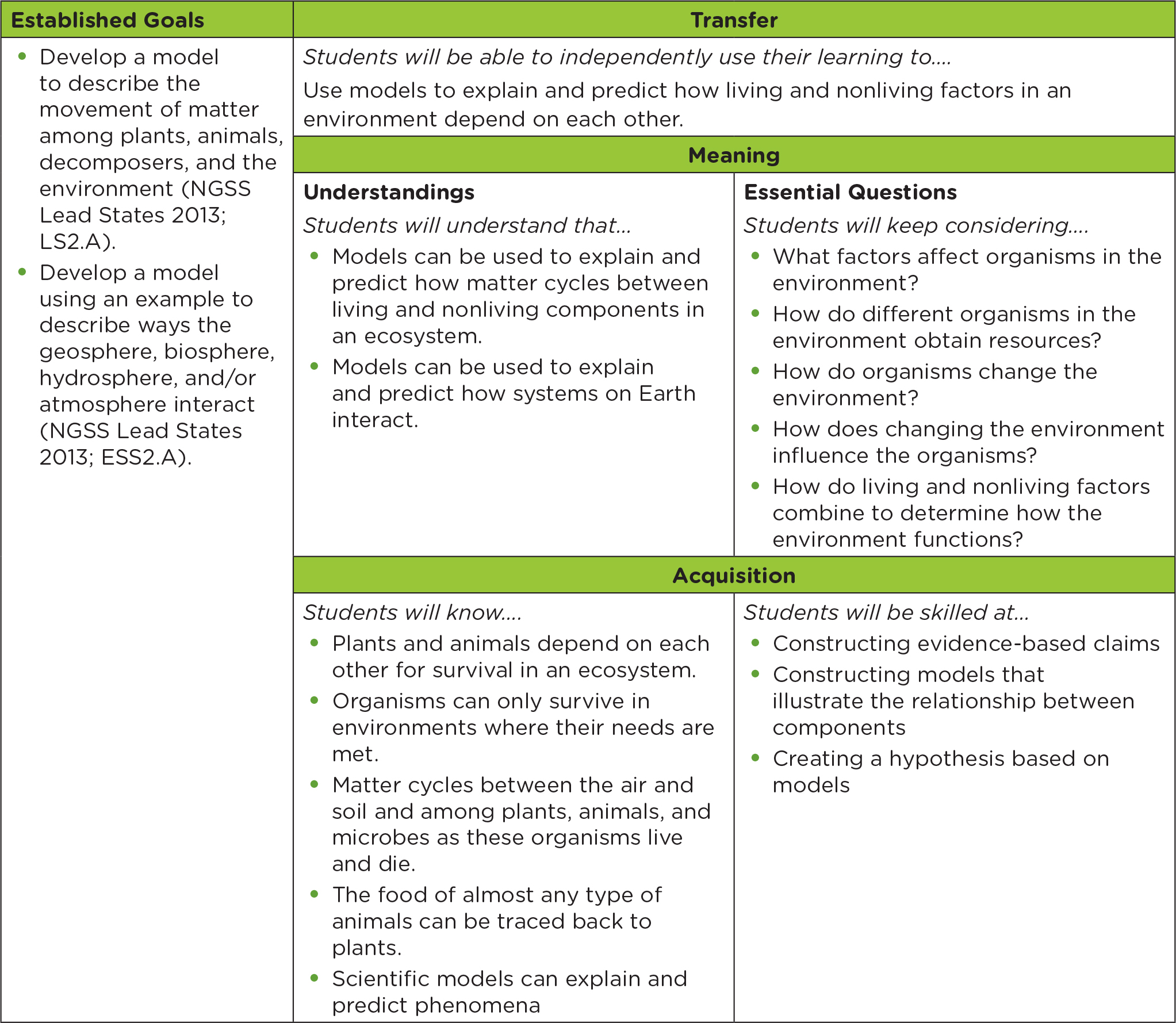
Stage 1 of the UbD unit template.
Stage 2 of UbD: As shown in Figure 2, the focus is on measurable ways to assess students and could serve as evidence of conceptual understanding. The assessment standards sought to determine student understanding and emerged seamlessly from the essential learning goals (all three levels: transfer, meaning, acquisition). First, based on students’ experiences, they should be able to construct Claims-Evidence-Reasoning (C-E-R) statements. A C-E-R statement provides evidence of their knowledge of the specific topic as well as an important cross-disciplinary and 21st century skill (using technical, informative writing to support and create an evidence-based argument; (NGAC and CCSSO 2010). Second, students would be able to use model-based reasoning to explain and predict the interactions within their ecosystems and to other environments. Acquisition knowledge facilitated their knowledge in the two other areas (transfer and meaning). Being able to explain the role of decomposers as well as explicitly knowing that scientific models both explain and predict sophisticated understanding. In sum, all three levels of desired learning goals were directly related to assessment to aid and evaluate transfer learning.
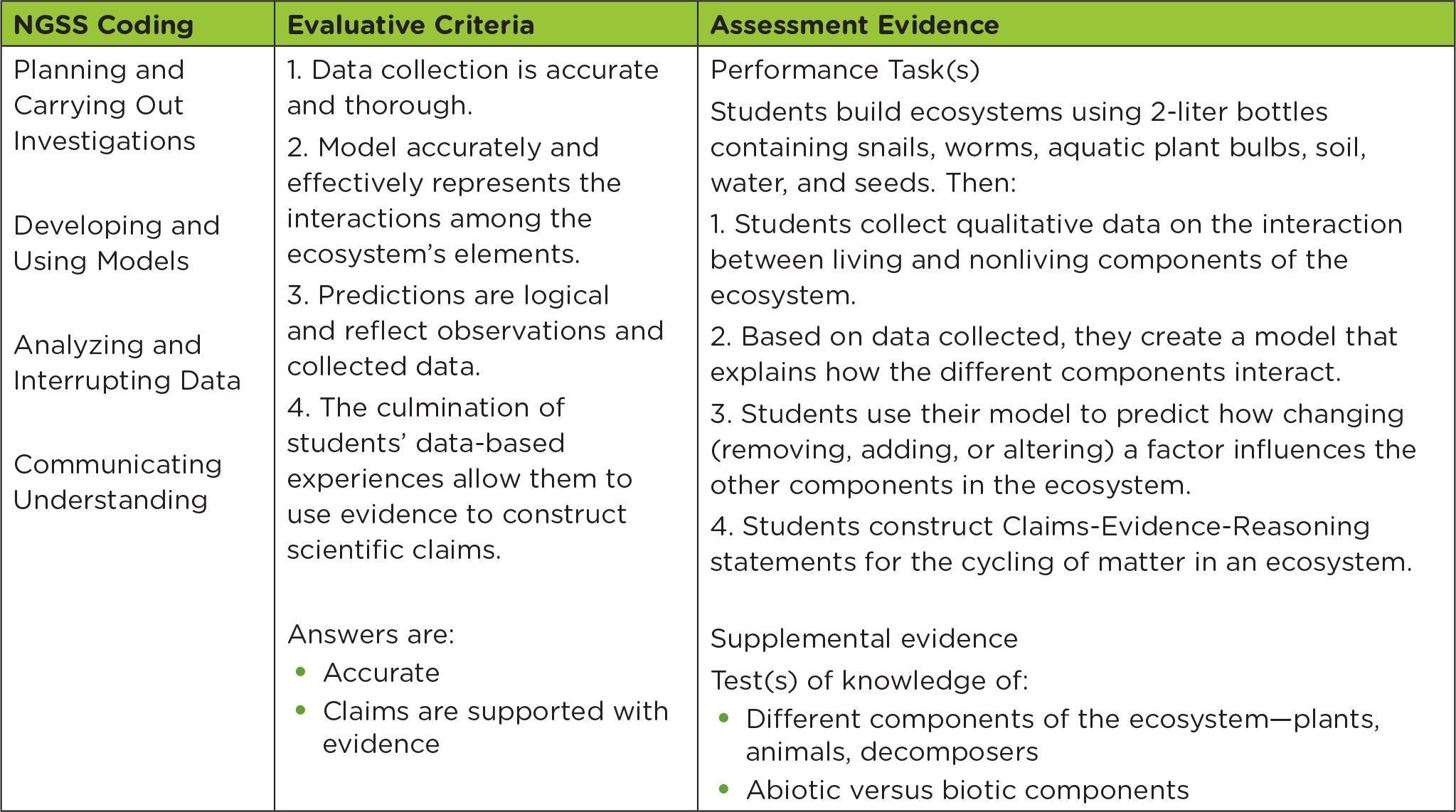
Stage 2 of the UbD unit template
Stage 3 of UbD: The learning plan for this unit applied an explore-before-explain lesson sequence to immediately engage students in light of the desired learning goals identified in Stage 1 and the planned assessments in Stage 2 (see Brown 2019). The learning activities began with an assessment probe to identify students’ initial ideas about living versus nonliving things (See Keeley, Eberle, and Farrin 2005). The probe was purposefully selected so that students could think and reason about the characteristics of living things to situate their firsthand experiences. The explorations were an extension of the assessment probe and focused on students constructing two-liter bottle ecosystems using snails, worms, aquatic plant bulbs, soil, water, and seeds (see Figure 3). Over time, students watched seeds sprout (see Figure 4), carefully observed snails eat, and witnessed condensation form (see Figure 5) as a result of the connection between the aquatic and terrestrial environments.
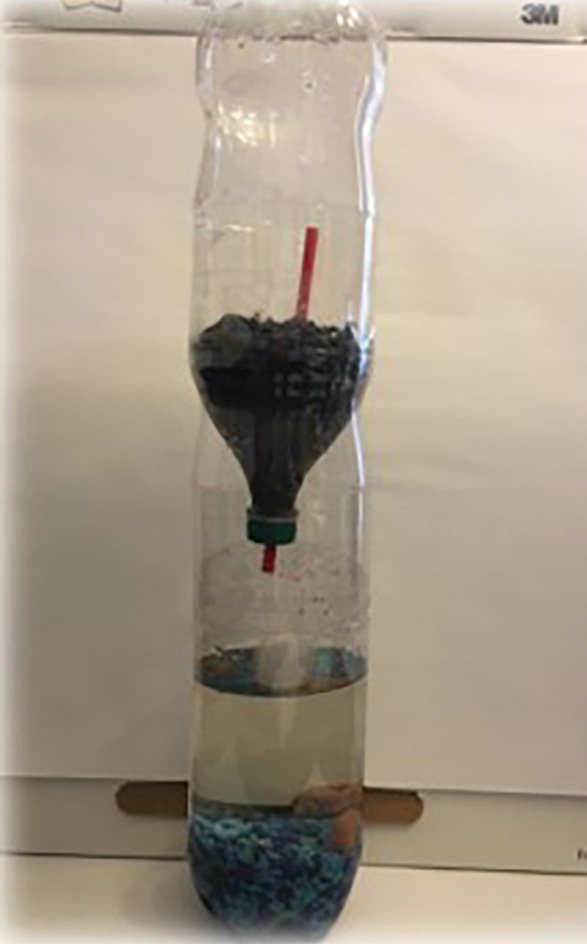
Student’s two-liter bottle ecosystem.
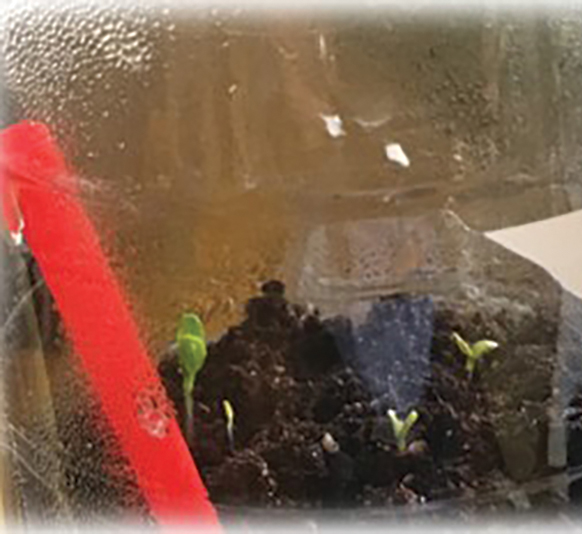
Student evidence of the connection between the living and nonliving things in an ecosystem.
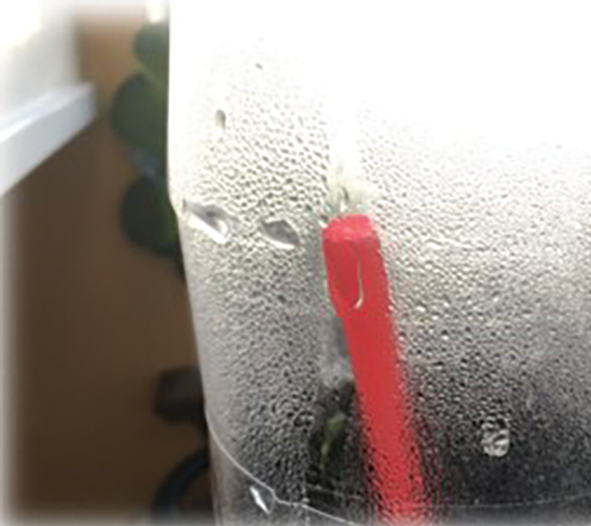
Student evidence of the connection between the living and nonliving things in an ecosystem.
These qualitative observations served as data for evidence that the different components of the ecosystem were linked. Students drew models illustrating the interconnections to explain the ecosystem. In addition, they used their models to predict how changing one aspect of the environment influenced another.
Students’ firsthand experiences were the hook for developing more sophisticated understanding and more in-depth explanations. Students engaged in a reading of There’s a Hair in My Dirt! A Worm’s Story (Larson 1998). The book introduced a set of ideas related to this unit of study. Students learn that “plants did a little more than just make the air crisp and clean—they made the air! Every molecule of oxygen in the Earth’s atmosphere was put there by a plant” (Larson 1998, p. 11). In addition, they learn about decomposers … “Take us worms, for example. We till, aerate, and enrich the earth’s soil, making it suitable for plants. No worms, no plants; and no plants, no so-called higher animals running around with their oh-so-precious backbones!” (Larson 1998, p. 52). The goal of the reading was to verify and refine students’ exploration experiences and introduce academic vocabulary to sophisticate student understanding.
Note: In this article, we have presented a brief description of a learning plan for this unit. A more detailed version, including samples of student work, can be found on the NSTA website (see NSTA Connection).
Conclusion
The NGSS calls for the fusion of content based on “big ideas” (via core ideas and crosscutting concepts) with the processes of science (science and engineering practices)—by design. Understanding by Design offers a practical and proven curriculum planning framework through which teachers can enact the vision of the NGSS by targeting understandings and transfer goals in Stage 1 and specifying the needed assessment evidence in Stage 2. Then, by following the explore-before-explain instructional sequence in Stage 3, teachers honor learners’ background knowledge, capitalize on their inherent curiosity, and actively engage them in making meaning through experiential learning. The understandings that students construct from direct experiences are powerful and enduring; they embody the NGSS call for learners to be “doing” science.
Internet Resources
AAAS: Assessment http://assessment.aaas.org/topics
Instructional Sequence Matters, Grades 3–5: Explore Before Explain https://www.nsta.org/store/product_detail.aspx?id=10.2505/
9781681406589
NSTA Connection
Download the NGSS connections associated with this unit at www.nsta.org/science-and-children.
Jay McTighe (jay@mctighe-assoiates.com) is an Educational Consultant at McTighe and Associates Consulting in Columbia, Maryland, and author of the Understanding by Design series with Grant Wiggins. Patrick Brown (plbtfc@gmail.com) is Executive Director of STEM at Fort Zumwalt School District in O’Fallon, Missouri.
Curriculum NGSS Pedagogy Elementary


